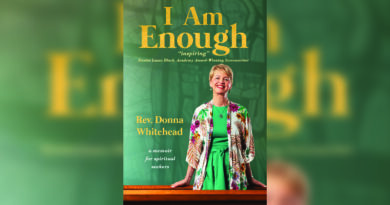Campus Museum Honors Military

Donated items from families shape exhibits
Set in a Quonset-style hut, much like those used by U.S. forces in World War I, is a gallery saluting the veterans of past wars.
Five mannequins, donning uniforms from each of the five branches of the military, greet visitors as they enter. Military memorabilia lines the walls and sits in display cases — from helmets to photographs to old war letters.
A military museum believed to be the first of its kind in the country. And it’s right in the backyard of Thomas C. Marsh Middle School.
“You’re not going to find a military museum on any public school campus or any school property,” said Cpl. Miriam Gaytan, the new frontrunner of the Marsh Leadership Cadet Corps. “It’s definitely a gem within its neighborhood, and our neighborhood is always open to anyone.”
The Marsh Military Museum was established in 2012, when the Marsh Leadership Cadet Corps wanted to create something to honor veterans.
The students of the LCC serve as the curators and use it as an opportunity to expand their knowledge. Veterans and their families donated the items that currently fill the space.
“We put out YouTube videos asking for donations, and people started bringing in things, emptying out their attics,” Gaytan said. “Before we knew it, we were full. It just grew and it got a lot of support. This is a total community project.”
Marsh Military Museum wouldn’t be at its present stage if it weren’t for the wishes of the Marsh LCC. And the LCC wouldn’t be here if it weren’t for Cpl. David Bates.

Bates moved to Dallas in 1998 after serving four years in the U.S. Army as an infantry soldier. He was hired by Dallas ISD to start a three-year ROTC program at the middle-school level, at a time where the ROTC concept was still in its infancy.
His assignment was Marsh Middle School.
Initially, Bates didn’t have a base classroom. There were no uniforms and no money, nor a curriculum. He did have 68 students to work with, and that was enough for him to make change.
Over time, the classes got bigger and the cadets got better. Two years into his tenure, Bates had a classroom and they had raised enough money to buy uniforms.
Based on trial-and-error, he was able to create his own curriculum. The program continued to go up from there.
“In 2007, these programs at the middle school level in Dallas and Fort Worth grew. Every urban school district in the country started adopting middle school ROTC programs to help with discipline,” Bates said.
That same year, the first national middle-school drill competition was held. Marsh LCC took home the title. It was the first of four championships and led to plenty of recognition.
As the years went on, the number of cadets tripled. The program upgraded its home base from a classroom to a building of its own, met with congressmen and city officials about the successes of the program, and found ways to give back to the community.
A simple glass case containing an old military helmet sparked the idea to give in a greater way.
“At the time, DISD had cancelled a lot of field trips, so we kind of had the idea of, ‘what if we bring the kids to our place?’” Bates said. “I saw the glass case behind my desk and came up with the idea of building a museum and putting this kind of stuff on display.”
Retired judge Bill Coker and his wife, Betty, supporters of the LCC program, got the ball rolling with a donation of $10,000. The project was funded solely on donations. Not a single DISD dollar was used.
Since the doors of Marsh Military Museum opened, visitors of all ages have passed through, and memorabilia continues to be donated. Gaytan considers the latter quite an honor.
“I understand that you aren’t going to give me your dad’s or your mom’s precious memories without first seeing how it’s going to be treated, honored and respected,” said Gaytan, who did seven years in the Marine Corps Reserves. “But when they hear a 12-year-old talking about the raising of the flag at Iwo Jima, then they’re like, ‘this is the right place to place them.’”
This story appears in the July issue of Preston Hollow People, on stands now.








